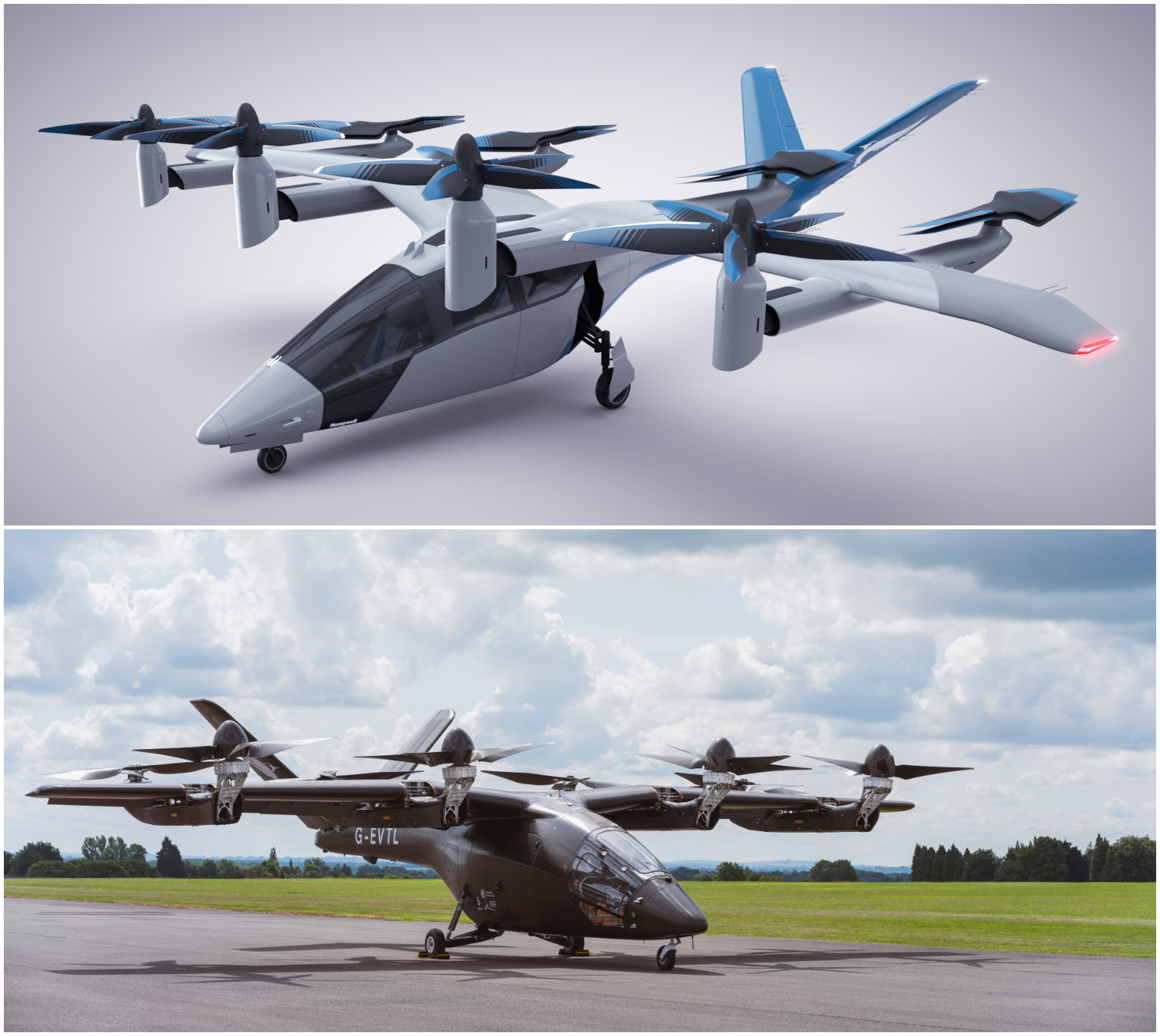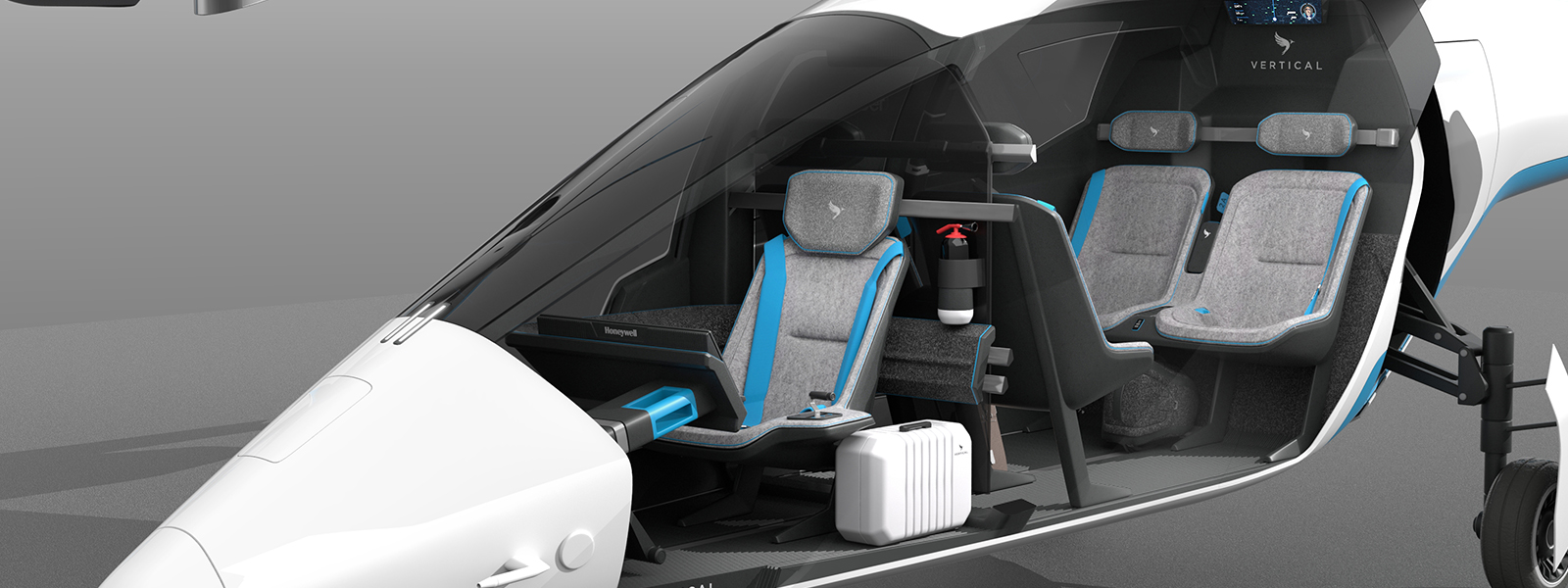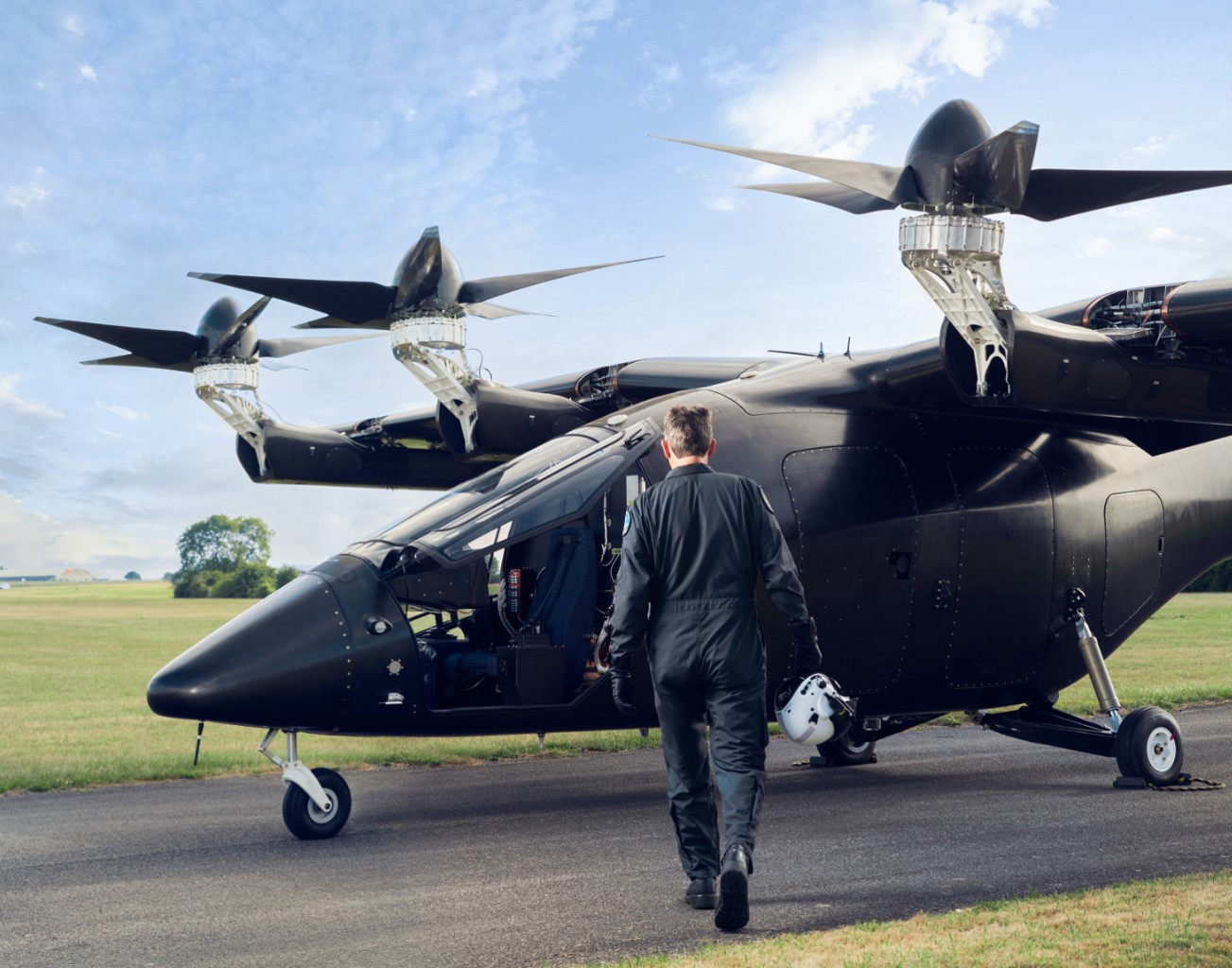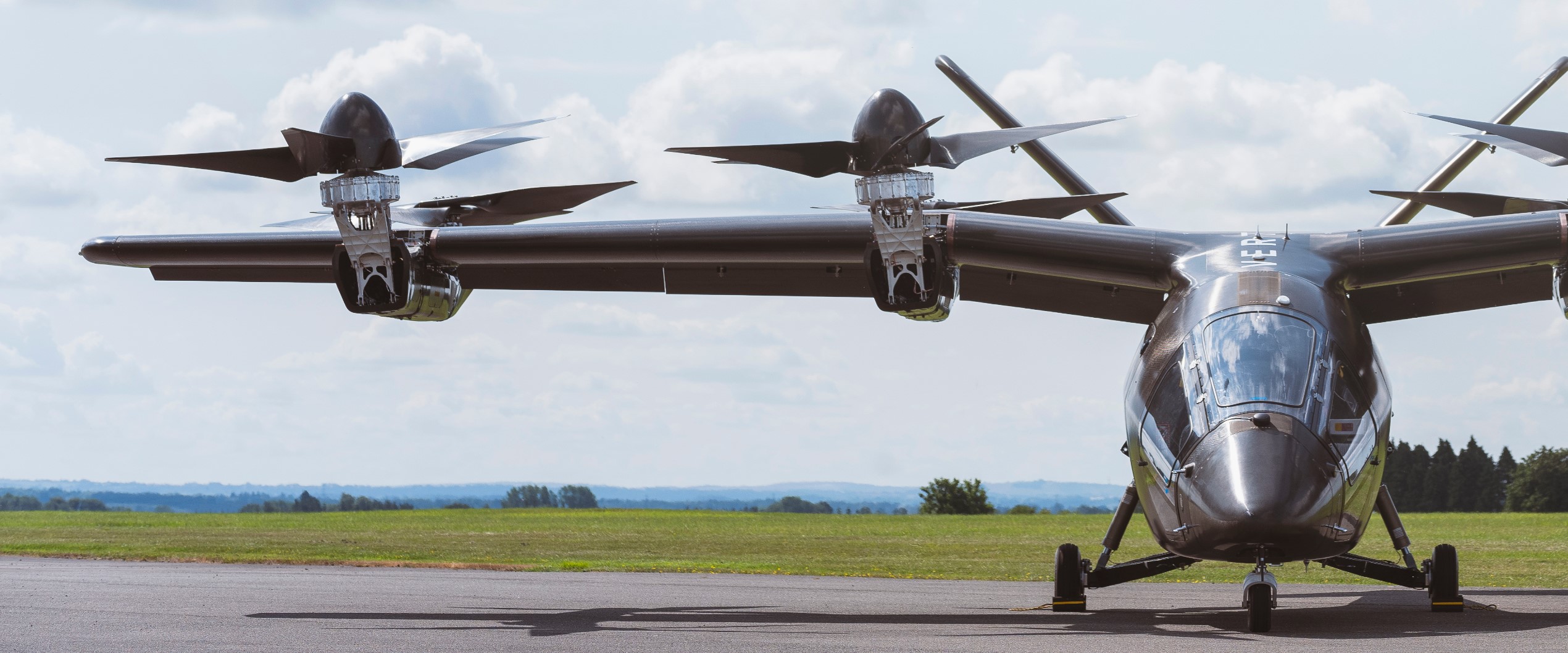Vertical Aerospace
Vertical Aerospace is building its revolutionary electric aircraft and defining its processes on the 3DEXPERIENCE platform on the Cloud with the Reinvent the Sky industry solution experience. This gives the company access to enterprise-level design, engineering and simulation software in a single, secure, standards-based environment.
Taxis take flight
The race to bring an electric vertical takeoff and landing (eVTOL) aircraft to market is on. One of the frontrunners, UK aviation startup Vertical Aerospace, is set to launch the world’s first certified winged eVTOL with the VA-X4. Quiet, efficient and carbon-emission free, eVTOL machines are praised as the next urban mobility solution. Innovators like Vertical Aerospace plan to move more freely and access local heliports and airports where noise regulations currently restrict the number of flights per day. Vertical Aerospace is targeting an aircraft that is significantly quieter than a helicopter – and will cost far less to run too – allowing it to tap into a market for travel between areas underserved by high-speed rail networks and regional airlines.
“What we’re witnessing is population growth in major cities where the ground base infrastructure such as road and public transportation is getting saturated and congested,” said Eric Samson, head of engineering at Vertical Aerospace. “Then there are helicopters, used for transportation around large cities, but they are increasingly facing landing restrictions due to noise levels, offer no safety redundancy and are cost prohibitive to the general public. We’re developing an electrically distributed propulsion system, which offers redundancy, is cheaper to run and maintain, will be about 30 times quieter than a helicopter and doesn’t sacrifice the planet.”
Vertical Aerospace’s VA-X4 has a winged design, which gives it lift and will reduce electrical load when in flight.
“The VA-X4 aircraft has been designed to carry five people – a pilot and four passengers,” Samson said. “We are targeting inter- and intra-city travel with a range of up to 100 miles at cruise speeds of 150mph. We’ve chosen a wing design because lift offers the benefit of speed, range and is very quiet in cruise conditions, which will help us stand out in this market.”
The company is currently building a demonstrator, which it plans to fly in the third quarter of 2021 before certifying and bringing the final aircraft to market in 2024. All of Vertical Aerospace’s product development is being defined and managed through the 3DEXPERIENCE® platform on Cloud allowing the company to innovate at speed and meet its ambitious targets.
“We’re in the process of writing a new chapter in the aviation industry,” Samson said. “We’re working with emerging technologies, including intuitive and safe flight control technologies from Honeywell. At the same time, we’re defining a new certification basis and collaborating with leading companies around the globe. The 3DEXPERIENCE platform will help us to develop and share the critical steps of requirements, ensure we’re developing the aircraft according to those requirements, do validation and also manage the certification of the aircraft with the authorities. It’s a one-stop shop and single source of truth for Vertical Aerospace and our business partners that allows us to work concurrently wherever we are in the world.”
Meeting core business needs
Vertical Aerospace is working with Dassault Systèmes’ business partner Desktop Engineering (DTE) to maximize how it takes advantage of the 3DEXPERIENCE platform. The company finds the support and guidance invaluable as it builds its processes and maps them to the platform’s functionality.
“The amount of functionality the platform delivers is hugely exciting,” said James McMillan, senior design engineer at Vertical Aerospace. “We’ve started by focusing on our core business needs and making sure we get these processes up and working, such as building a product structure and implementing a part numbering system which is future proof and will support configuration control. When we have fleets of operational aircraft, we need complete traceability of all the parts.”
“We’ve been working collaboratively with DTE and Dassault Systèmes to build our product structure and future proof it,” McMillan said. “But equally we have a really tight program so there’s lots we have to do right away such as getting the part numbering system in place. The guidance from both DTE and Dassault Systèmes has been amazing.”
Vertical Aerospace opted for a cloud-based version of the 3DEXPERIENCE platform to suit its immediate and growing business needs.
“The cloud ensures business resilience and allows us to continue working from any location at any time,” Samson said. “Having all our data reside on the cloud ensures a single source of truth while saving us any upfront capital investment. All of our apps are always up-to-date and we can add and remove functionality according to our changing requirements.”
The 3DEXPERIENCE platform will help us to develop and share the critical steps of requirements, ensure we’re developing the aircraft according to those requirements, do validation and also manage the certification of the aircraft with the authorities. It’s a one-stop shop and single source of truth for Vertical Aerospace and our business partners that allows us to work concurrently wherever we are in the world.
Defining processes and products in parallel
McMillan’s role at Vertical Aerospace is to define the company’s processes and implement a standardized, lean way of working across the organization.
“As soon as I saw what Vertical Aerospace was trying to do, I was blown away,” he said. “I love their vision, their green credentials, the innovation and the fact we’re developing brand new technology. We’re building an aircraft from the ground up and starting completely from scratch. So not only do we need to get our processes in order for the now, we need to future-proof them too.”
Alongside its product development, then, the company is putting in place industry-standard processes, all supported by the 3DEXPERIENCE platform. One of the key areas the platform is helping with is change management.
“My experience of change management is that it’s usually spread across multiple platforms,” McMillan said. “But we’re handling all the end-to-end data management on 3DEXPERIENCE. In our decision meetings we can send actions out to people via the platform, record the sessions and the workflow supports that. We also will be able to set up signatory loops for key people to sign off documentation.”
This functionality is particularly important as the company advances to the next stages of its product development.
“The end-to-end change process is really important for us, especially as we look to the future,” McMillan said. “We will be able to map change management with configuration control, allowing us to set effectivity ranges on design solutions to make sure that they’re applicable to certain groups of aircraft. Today, we go to a single user, single log in and you’re able to see the entire process cradle to grave. It’s phenomenal. When we start producing aircraft and services, we are hopeful that we can achieve a fully 3D process with our suppliers, exchanging digital data all the way from production planning down to customer service, maintenance and repairs.”
With a fully connected product development lifecycle, Vertical Aerospace can work fast and collaboratively.
“We’re developing a new product so we want to use the latest, best platform to do that and it’s particularly exciting that we can work in partnership with DTE and Dassault Systèmes to set it up,” McMillan said. “I think that we could set a benchmark for how people work in the aerospace industry.”

Innovating in a 3D world
Vertical Aerospace’s engineers use CATIA to design parts in 3D for the aircraft structure.
“We needed a CAD package that had the power to cope with the whole aircraft,” said John Russell, senior design engineer at Vertical Aerospace. “We knew CATIA could do that.”
For example, CATIA brings together a complete set of process-oriented functions, allowing engineers to design and validate composite structures all from the 3DEXPERIENCE platform.
“This is a composite aircraft primarily,” Russell said. “When you design in other CAD packages, you tend to simplify composite structure. But the analysis work that goes into composites and understanding plies, orientations and layers of composites is complicated. With this platform, very early on we could build a composite part using a composite workbench to build up the layers and plies. It takes a bit more time to set it up, but when there is more analysis being done, we can look at the best way to manufacture the part from start to finish; it is a far quicker process. In the future, we will be able to give this digital data to manufacturers and go straight to manufacturing.”
Importantly, the 3DEXPERIENCE platform enables Vertical Aerospace to build a virtual twin of the aircraft and incorporate all aspects, from aerodynamics to electronics.
“We’re mapping out the 2D electrical functional work and linking it directly to the 3D model,” McMillan said. “Soon, we will have the ability to link the 2D and 3D into the whole system architecture so that we can map it from the top-level aircraft definitions with requirements all the way down to the 2D and 3D. Everything will be in one place; we’re not looking around for different datasets and transferring data across. It’s a single source solution. So, if you move or change some of the functional work, it gives you an alarm that your 3D model needs updating. Equally, if you change the geometry, we get feedback to amend the 2D.”

All disciplines in one place
With the 3DEXPERIENCE platform, Vertical Aerospace is able to carry out concurrent engineering and empower all users in the company to access the information they need to keep projects on track.
“The platform brings all teams together and means that non-CAD people can see the data too,” Russell said. “The aircraft initially starts with the aerodynamics team making a pleasing shape of the aircraft and doing the analysis and an aerodynamic flow over the aircraft. We have a master geometry surface and we’ve linked our CAD data to this, so when they change the aerodynamic shape, our CAD models are quickly updated too. People who don’t have CAD access can see all this in the web-based app. They can see the aerodynamic shape, the structure and interrogate the bill of materials. For everyone to see the parts and models and define a project plan – that’s a really big deal.”
The company is growing its partner and supplier network to bring its aircraft to market and will use its 3D model to hand over specific information and instructions to key stakeholders down the supply chain.
“We are a strong believer in working partnerships with very capable companies,” Samson said. “For example, Honeywell is developing our flight control systems and has a lot of experience with VTOL technologies. We are willing to create partnerships with companies that are agile, eager to disrupt and bring new technologies to market that will allow us to scale up to meet demand. It allows us to accelerate the development of the aircraft and certification process to 2024, which otherwise would have taken us much longer.”
“We’re including all the analysis work from the stress and aerodynamics teams and so forth into our 3D model-based definition on the 3DEXPERIENCE platform,” Russell added. “Having all the manufacturing and assembly information and installation instructions already integrated into the model will make the handover to manufacturing far easier and much more effective.”

A new chapter in aviation
As Vertical Aerospace brings its aircraft to market, it is working closely with the safety regulator CAA (Civil Aviation Authority) to help shape the regulations and define new levels of safety in the industry. It is this close working relationship combined with the company’s vision, innovative design and advanced technologies that will give it a clear route to certifying its aircraft.
“The 3DEXPERIENCE platform will give us full traceability and help us to achieve a DOA certification from CAA,” McMillan said. “We want to be first, but we also want to be the best.”
With the 3DEXPERIENCE platform at the heart of its operation, Vertical Aerospace has all the capabilities it needs to redefine the future of air travel.
“You’re only limited by your imagination,” McMillan said. “We’re building the company from the ground up and we have to take the modular approach. But we’re also looking to the horizon and we’re excited about the potential of what we can achieve with the platform – and that is a completely digital representation of the aircraft. Everywhere I’ve looked for a solution, I’ve found it on the platform. It’s so exciting.”

Focus on Vertical Aerospace
Founded by greentech entrepreneur Stephen Fitzpatrick in 2016, Vertical Aerospace is disrupting the way aircraft are developed. Combining the rigor and discipline of aerospace with the pace and agility of F1 enables Vertical to develop cutting-edge electric aircraft. The company is already a global pioneer in sustainable aviation technologies, as one of only a handful of companies to have flown multiple full-scale eVTOL prototypes with UK Civil Aviation Authority approval.
For more information: www.vertical-aerospace.com

Focus on Desktop Engineering
Desktop Engineering (DTE) provides full turnkey solutions for CAD, CAM, FEA, CAE, and PLM solutions. As a fully accredited Dassault Systèmes platinum partner, it helps customers overcome their challenges and become super users in CATIA, 3DEXPERIENCE, SOLIDWORKS, ENOVIA, DELMIA, and 3DVIA to name just a few software products.
For more information: https://dte.co.uk/

